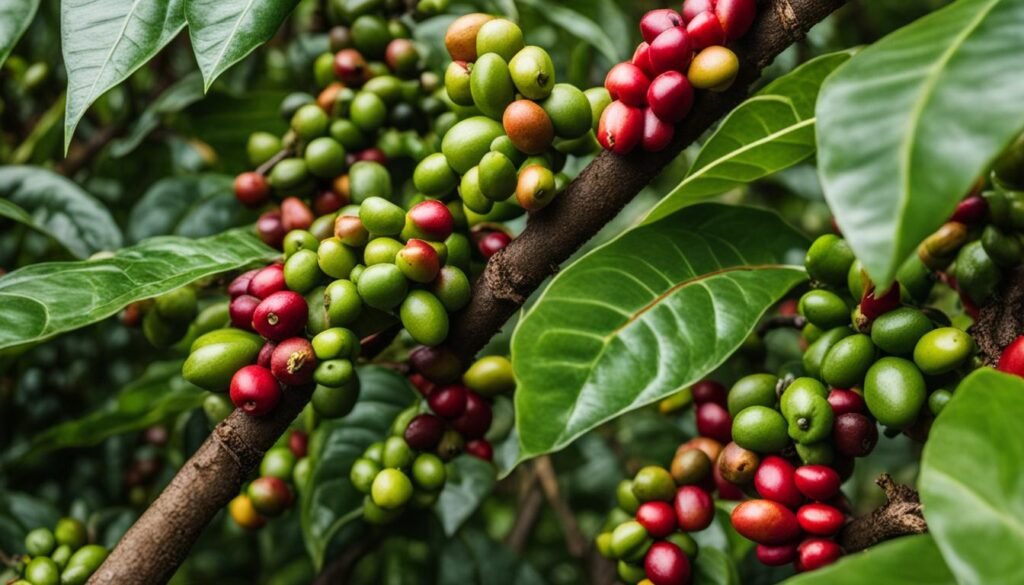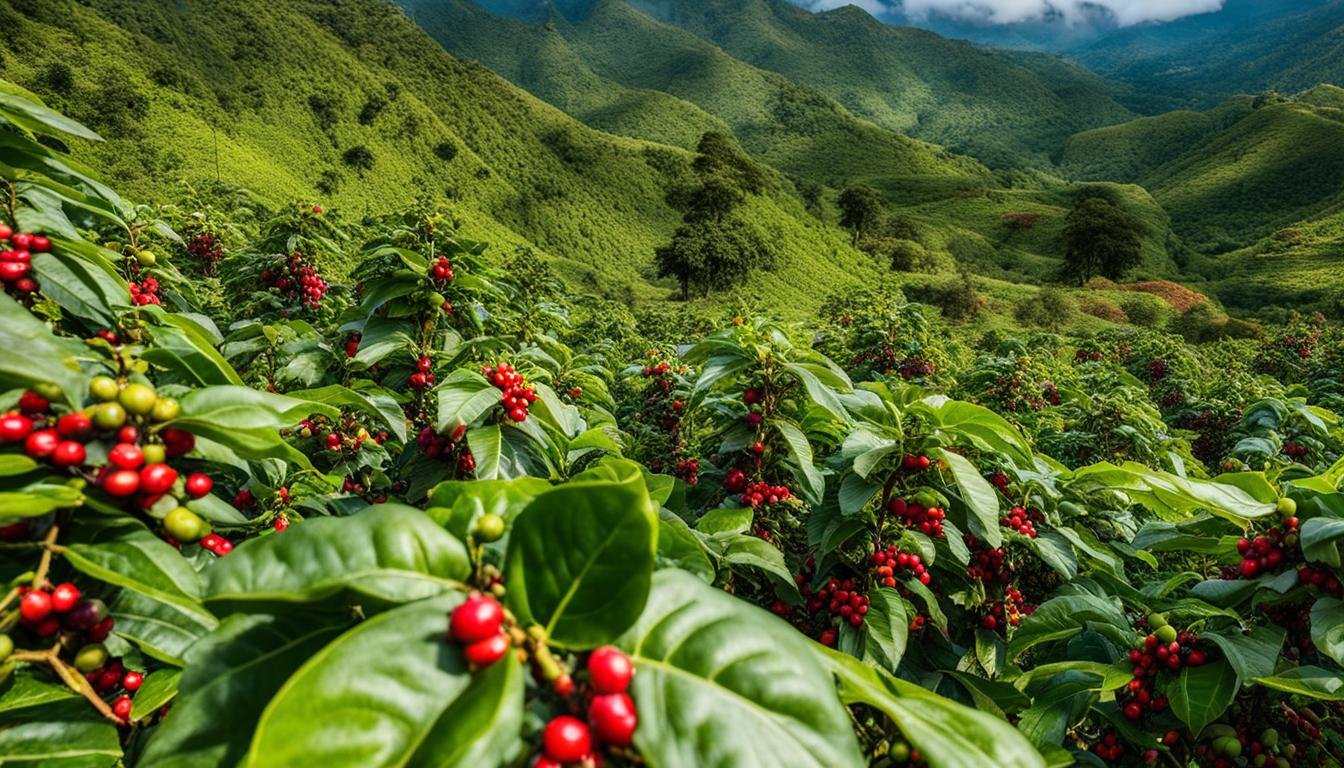Welcome to our coffee journey! Have you ever wondered where those delightful coffee beans come from? We’re here to uncover the secrets of coffee plants, cultivation, and the fascinating process of coffee bean production. Join us as we delve into the world of coffee farming and plantations!
Coffee beans, the precious seeds of coffee cherries, have a remarkable journey from tree to cup. Let’s start by exploring how coffee beans are grown on trees, cultivated, and transformed into the aromatic beverage we all love.
Key Takeaways:
- Coffee beans are the seeds of coffee cherries that grow on trees.
- Coffee trees require about three to four years to produce fruit, known as coffee cherries.
- The harvesting process can be done by hand or using machines, with two methods: strip picking or selectively picking.
- Harvested cherries are processed through the dry or wet method to access the precious coffee beans.
- Coffee beans are further processed, sorted, and priced before being exported for sale.
Understanding Coffee Tree Varieties and Cultivation
When it comes to coffee farming, understanding the different varieties of coffee trees is essential. Coffee plants can take on various forms depending on their species, growing environment, and cultivation practices. While some coffee species can grow into tall trees, others are considered treelets or shrubs. One of the most popular species, Arabica, is generally considered a small tree, whereas canephora is also classified as a small tree but is commonly known as robusta.
In the cultivation process, coffee plants are often pruned or grown as dwarf clones to resemble shrubs. This practice serves practical purposes, such as facilitating harvesting and ensuring optimal fruit production. As coffee trees grow, they require careful management to maintain their desired shape and size. This involves regular pruning and shaping to control the plant’s growth and enhance its productivity.
Different coffee tree varieties also have unique characteristics that contribute to the flavors and aromas of the coffee beans they produce. The specific species, along with factors like soil composition, elevation, and climate, play a significant role in determining the final taste of the coffee. Farmers carefully select the appropriate coffee tree varieties and cultivate them in specific regions to create distinct flavor profiles that coffee enthusiasts around the world appreciate.
Factors Influencing Coffee Tree Cultivation
- Climate: Coffee plants thrive in tropical climates with temperatures ranging between 60°F (15°C) and 70°F (24°C). They require a combination of warm temperatures, humidity, and rainfall to grow and produce fruit.
- Elevation: The altitude at which coffee plants are grown impacts their flavor. High-altitude cultivation, typically above 3,000 feet (900 meters), often results in coffee with more nuanced flavors and increased acidity.
- Soil Type: Different soil compositions affect the nutrient availability and drainage of coffee plants. Volcanic soil, for example, is known for its rich mineral content, which can contribute to the unique flavor profiles found in coffees from regions like Ethiopia and Costa Rica.
- Cultivation Practices: Farmers employ various cultivation techniques, such as shade-grown coffee and organic farming, to enhance the quality and sustainability of their coffee beans. These practices promote biodiversity, protect the environment, and contribute to the overall flavor of the final product.
Understanding the different coffee tree varieties and the factors that influence their cultivation allows us to appreciate the diverse range of coffees available. From the small trees of Arabica to the hardy shrubs of robusta, each variety brings its own distinct characteristics to the world of coffee, ensuring that there is a brew for every palate.
The Geographical Factors Impacting Coffee Bean Growth
When it comes to coffee bean harvesting, geographical factors play a crucial role in determining the quality and flavor of the beans. Coffee beans thrive in regions located around the equator, known as the “bean belt,” which stretches between the tropics of Capricorn and Cancer. These regions provide the ideal conditions for coffee plants to flourish and produce exceptional beans.
The climate, elevation, and soil type in these coffee-growing regions greatly influence the taste and characteristics of the beans. For instance, coffee beans grown at higher elevations tend to have a more complex flavor profile, while those grown at lower elevations may exhibit sweeter and milder tastes. The unique combination of temperature, rainfall, and soil composition creates a distinct terroir that contributes to the regional flavors of coffee.
The Role of Climate
The climate in coffee-growing regions is of utmost importance. Coffee plants prefer stable temperatures between 60°F and 70°F (15°C to 24°C) with minimal fluctuations. The consistent warmth allows the plants to grow steadily and produce high-quality cherries. However, different coffee tree varieties have varying temperature preferences, which is why certain regions are better suited for specific types of coffee beans.
The Influence of Elevation
Elevation plays a significant role in coffee cultivation. Generally, coffee grown at higher elevations tends to have a more desirable taste. The cooler temperatures and increased atmospheric pressure at higher altitudes prolong the maturation process of the coffee cherries. This extended ripening period allows the flavors to develop more fully, resulting in beans with complex and nuanced profiles. In contrast, coffee grown at lower elevations often produces beans with milder and less distinct flavors.
The Impact of Soil Type
The soil type also affects the growth and quality of coffee beans. Well-drained and fertile soils rich in organic matter provide the necessary nutrients for the coffee plants to thrive. Volcanic soils, for example, are highly prized for their mineral content, which imparts unique flavors to the beans. Different soil compositions contribute to the diverse range of taste profiles found in coffee from various regions.
Understanding these geographical factors is essential for coffee enthusiasts and professionals alike. They allow us to appreciate the distinct qualities of coffee beans from different regions and make informed choices about the flavors we prefer. So, the next time you savor a cup of coffee, take a moment to consider the impact of the environment in which those beans were grown.
Exploring Different Types of Coffee Beans

When it comes to coffee beans, there are a variety of options to choose from. The two most common types are Arabica and Robusta. Arabica beans are known for their complex flavors and higher acidity levels. They have a sweeter taste and are often favored by coffee connoisseurs. On the other hand, Robusta beans have a stronger flavor with lower acidity levels. They are commonly used for producing espressos and are known for their rich flavor and higher caffeine content.
The Characteristics of Arabica Coffee Beans
- Complex flavors
- Higher acidity levels
- Sweeter taste
- Larger size
Arabica beans are often oval-shaped and larger in size compared to Robusta beans. They are grown at higher elevations and have specific growing requirements. Arabica beans are typically more expensive due to their desirable flavor profile and the efforts involved in cultivating them.
The Profile of Robusta Coffee Beans
- Strong flavor
- Lower acidity levels
- Smaller size
- Higher caffeine content
Robusta beans, on the other hand, are smaller and more circular in shape. They are known for their strong and bold flavor, making them a popular choice for espresso blends. Robusta plants are hardier and can withstand diverse climatic conditions, which contributes to their lower price compared to Arabica beans.
Whether you prefer the nuanced flavors of Arabica or the robustness of Robusta, the type of coffee bean you choose can greatly impact the taste of your brew. Exploring different varieties and understanding their characteristics allows us to appreciate the diversity and complexity of coffee beans.
Conclusion
The journey of coffee beans, from production to your cup, involves a fascinating process that starts with the harvest from coffee trees. These trees, grown from the seeds of coffee cherries, take several years to produce fruit. Through careful cultivation, harvesting, and processing, the cherries are transformed into the coffee beans we know and love.
Understanding the origins of coffee beans is key to appreciating the diversity and characteristics they offer. Different coffee tree varieties and cultivation practices contribute to the wide range of flavors and aromas found in coffee beans. It is the combination of geographical factors, including climate, elevation, and soil type, that gives each region’s coffee beans their unique taste.
When you sip your cup of coffee, take a moment to think about the journey those beans have taken. From the hands that carefully picked them to the processing facilities that prepared them, each step plays a vital role in bringing you the rich and flavorful beverage you enjoy. The production of coffee beans is a labor of love that spans the globe, connecting coffee lovers everywhere.
FAQ
Do coffee beans actually grow on trees?
Yes, coffee beans are the seeds of coffee cherries, which can be grown into coffee trees.
How long does it take for a coffee tree to start producing fruit?
It typically takes about three to four years for a coffee tree to begin producing coffee cherries.
How are coffee cherries harvested?
Coffee cherries can be harvested either by hand or using machines through methods like strip picking or selective picking.
What happens to the coffee cherries after they are harvested?
The harvested cherries are processed through either the dry or wet method to remove the flesh and access the coffee beans.
What determines whether a coffee plant is classified as a tree or a shrub?
The specific species of coffee determines whether it is considered a tree or a shrub. Arabica and canephora are generally considered small trees.
Where are coffee beans primarily grown?
Coffee beans are primarily grown in regions located around the equator, known as the “bean belt.”
What are the most commonly consumed coffee bean varieties?
The most commonly consumed coffee beans are Arabica and Robusta, each with their own unique characteristics and flavor profiles.
What is the journey of coffee beans from planting to roasting?
Coffee beans undergo a complex process of cultivation, harvesting, and processing before they are roasted and eventually make it to your cup of coffee.

Leave a Reply